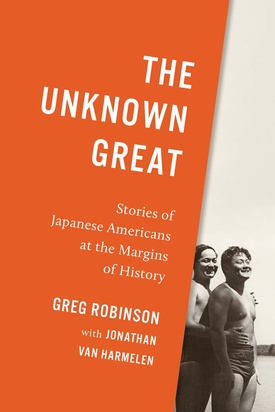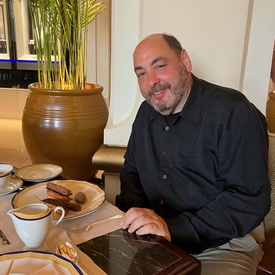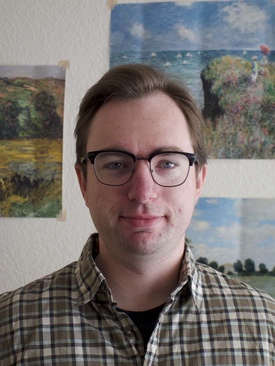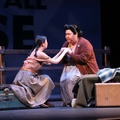Until recently, the history of Japanese Americans was documented almost wholly by looking at the WWII years. Whether they were seen as victims of forced removal and internment or as heroes while serving in the military, certain stereotypes of the group prevailed: stoicism, insularity, group consciousness, and “gaman” translated as perseverance or tolerance. But there remained an overlooked history that could expand that narrative.
Greg Robinson’s latest book, The Unknown Great, written with Jonathan Van Harmelen, explores new topics and themes in Japanese American history by profiling exceptional individuals. Their areas of research include the relationships between Japanese Americans and African Americans, activism within the LGBTQ community, attitudes about racism and romance as reflected in literature, and Nikkei contributions to the arts and culture both in the U.S. and abroad. Here, we meet musicians, writers, philanthropists, activists and rebels from the end of the 19th century to the present.
Greg is a Professor of History at l'Université du Québec, in Montreal, Canada, who writes a regular historical column, “The Great Unknown and the Unknown Great,” for Nichi Bei News, a San Francisco newspaper, as well as for Discover Nikkei. A number of those columns are included in The Unknown Great. He initially became interested in Japanese American history while researching the writings of Franklin Delano Roosevelt and his leading role in the issuance of Executive Order 9066 and beyond.
Greg’s award-winning books, By Order of the President: FDR and the Internment of Japanese Americans and A Tragedy of Democracy: Japanese Confinement in North America, made important contributions to wartime history. His subsequent publications, After Camp, The Unsung Great, and now The Unknown Great, have opened the door to examining novel themes in Japanese American history.
Jonathan is a PhD candidate at UC Santa Cruz, specializing in Japanese American incarceration. He grew up near Guadalupe, in what was once one the largest Japanese American communities in California. An internship at the National Museum of American History led him to interview Tetsuo and Betty Furukawa in Santa Maria. Learning about their experiences at the Gila River War Relocation Center changed the course of his academic research.
Since 2019, he has written several articles on Japanese American history for TIME, the Chicago Tribune, and the Los Angeles Review of Books. He regularly contributes to several Asian American newspapers, including the Rafu Shimpo, the International Examiner, and the Pacific Citizen.
Through their shared interest in wide-ranging topics related to Japanese American history, Greg and Jonathan have become collaborators. They agreed to be interviewed via email which follows:
* * * * *
For Greg—How has your focus on JA history evolved since the publication of your first book, By Order of the President?
Greg: It is now over 20 years since I published By Order. While By Order remains the work for which I am the best known, and I am proud of it, my focus has expanded past the questions it addressed of government policy in the wartime era to uncovering the long history of Japanese in America, and the careers of the fascinating but unsung artists, writers, activists, and others who helped make up the community.
I hope that all these stories I have collected and reported in The Unknown Great, along with many others, can be considered as representing collectively a counter-history of Japanese Americans, one that defies conventional ideas about the group.
For Jonathan—Have your interests changed during your PhD program?
Jonathan: It’s an interesting question. I actually began writing for Discover Nikkei in 2019, around the time I started my PhD, and so I can trace how my tastes have evolved since then. While my overall interest in Japanese American history has remained consistent, my approach to writing that history has shifted.
Since I started writing for Discover Nikkei, I have grown more interested in journalistic writing to communicate with a greater audience outside of academia. More recently, I try to stay focused on my dissertation on Congress and the incarceration of Japanese Americans, and on occasion I write a piece that stems directly from that project.
But Greg and I always find something new and exciting to write about in many different areas, whether it is related to literature, the arts, music, or civil rights.
For both—Has working together affected your areas of concentration?
Jonathan: Absolutely! Since I started collaborating with Greg, I think my research interests have increasingly overlapped with his. Even more, as you can see in our book, working with Greg has shaped my interest in telling history through biography. For both of us, biographical studies offer the chance to understand the life and experiences of an individual in all of their complexity. There are some limitations as to what we can write about—after all, much in people’s lives remains private and inaccessible—but immersing ourselves in documents helps us sketch out the life of a subject and understand what made them so fascinating or influential.
For instance, we found the story of Kinjiro Matsudaira, a young hapa man at the beginning of the 20th century who was the son of an immigrant engineer from Tokugawa Japan. He ran away from home at one point and became a circus performer, and later became likely the first Asian American elected official in the United States when he was elected as mayor of Edmonston, Maryland in the 1920s.
Greg: Working with Jonathan has definitely shaped my research in certain areas. For instance, Jonathan’s experience as a percussionist and his expertise in classical music whetted my appetite for doing articles with him about Japanese American musicians and music making, especially in the WRA camps.
His pieces on the history of the Maryknolls, the Catholic missionaries who sponsored schools and churches in prewar Japanese communities, not only fueled my own interest in Maryknoll but informed my larger studies into the history of encounters between Japanese Americans and the Catholic Church.
The mass removal and confinement of Japanese Americans during WWII launched a wave of activism acknowledging the shared struggles of black Americans and Japanese Americans, but that was not the beginning of interactions between the two groups. The examples of Nikkei students attending historically black colleges prior to the war seems like a little-known phenomenon. Was it difficult to find sources of Nikkei and black American or other minority group interactions prior to WWII?
Greg: The answer is that it is complicated. On the one hand, in the years prior to World War II, most Japanese Americans lived in Hawaii or in rural areas along the Pacific Coast, where African Americans were rare—though Issei and Nisei did work with farmworkers of Filipino and Hispanic ancestry—and it was not easy to find information on any interactions. However, Japanese Americans in places like New York and Los Angeles DID have interactions with other minorities. These were recorded in Japanese American media, and to a lesser extent in other sources.
I was delighted to find how central Blacks were to the Nikkei in those days, both as actual individuals and as a presence in society. Something that is not in the book is the story of the time, back in 1913, when the celebrated educator Booker T. Washington visited Seattle. He was fêted" by the local Isseicommunity, who raised money to fund a scholarship at Tuskegee Institute—a story I hope to include in a future volume.
Jonathan: Much of our work is, in a sense, archaeology. At times, we spend hours sifting through documents to find any evidence—even just a casual mention—of connections between Nikkei and other groups. In some cases, we have to draw conclusions based on whatever fragmentary evidence we have, and speculate about the rest.
We are always delighted to find mentions of Japanese Americans in African American newspapers like the Chicago Defender, the Pittsburgh Courier, and the New York Amsterdam News. For example, when we did our research on Nisei singers Mariko Mukai Ando and Ruby Yoshino Schaar, we found that both performed alongside African American musicians and were mentioned in the African American press.
When we get really lucky, we find rich stories that go beyond our expectations. In some cases, our research has taken us in unexpected directions. Take our study of Carlos Bulosan and his connections with Japanese Americans, which is not in this book. When I read Bulosan’s seminal work America Is In The Heart, I was intrigued by his various mentions of Japanese Americans throughout his travels in California. Greg had also previously done research on Bulosan that he had never used, and from there, we navigated various archives and online databases to put together a complete study on his relationship with the Japanese American community.
So many contemporary issues—women’s rights, racism against and within minority groups including the LGBTQ community, institutional discrimination—are addressed in these profiles. Examining the literature, Brian Niiya argues that racial conflicts are sometimes revealed more fully in fiction—or “community writing”—than in the writing of history. This is another seemingly under examined area of study, particularly pieces written prior to WWII. What do you make of the underlying prejudices of Nikkei writers and do you see a difference in attitudes pre and post war?
Greg: What Brian and I said (paraphrasing the historian Arthur M. Schlesinger, Jr.) is that racial ideas and attitudes in regard to minorities are frequently absent from the “conscious” (historical narrative) of a group, but are widespread in their “unconscious” (literature and art). It is notably difficult to unpack the racial prejudices of past generations, and what underlay them, but the record strongly suggests that both in the prewar and postwar periods, young Nisei varied widely in their attitudes towards African Americans, going from sympathy and outrage over prejudice—and times admiration of outstanding individuals such as Paul Robeson or James Weldon Johnson—to disdain or hatred.
Japanese Americans may have been thrown in closer contact with Black communities after the war, when more Nikkei bonded with black neighbors or friends, but familiarity also sometimes begat contempt on both sides.
Jonathan: Literature is a great medium for delving into difficult topics because it allows a writer the opportunity to address sensitive topics in a more indirect manner. Literary pieces offer a window into what Greg calls “unconscious” attitudes. In the case of Nikkei views of other groups, while it’s hard to synthesize the general attitudes of a whole community—especially one as diverse as the Japanese American community—it is clear that the young Nisei, like members of other ethnic groups, faced great pressure to adopt prevailing stereotypes of other groups as a means of conforming to white American society.
Literary pieces by writers such as Kenny Murase or Mary Oyama provide a useful window into popular perceptions. Readers today not only get a glimpse of what general attitudes were at the time, but also the tension of having to accept such views.
The Unknown Great adds to the record of the Nikkei community’s collaborations and conflicts with the African American community. It also examines religion, music. literature, journalism and breaks new ground on sexuality. In a chapter devoted to the queer history of Japanese Americans, you note that “the full contributions of mixed couples and their children still remain to be discovered.” Did you have to leave stories on the “cutting room floor” that suggest new areas to explore? What’s next?
Greg: Conventional portraits of Japanese Americans start from the false premise that, at least until recent times, mixed couples were stigmatized and their offspring rare. In fact, a large fraction of prewar Issei men, especially outside the West Coast, had non-Japanese partners, and their mixed-race children comprised many of the community’s earliest writers and artists.
What is interesting about The Unknown Great is that it features portraits of mixed-race Nisei who were able to make places for themselves in mainstream culture. As Jonathan mentioned, there is Kinjiro Matsudaira, who was elected mayor of a town in Maryland in 1927. There were performers Marion Saki and Ruth Sato, who were able to win roles in Broadway shows in the 1920s and 1930s, long before “race-blind casting” was a thing.
In the period 2019-2022, during which almost all the pieces in The Unknown Great were first produced, I published not less than 100 articles, either alone or together with Jonathan. For reasons both of space and focus, a large percentage of these had to be left out of the final book, including entire categories such as Japanese American visual artists and film actors. I also omitted some tributes to important people in my life, such as the historian Roger Daniels. But I think this represents a good selection of noteworthy columns.
Jonathan: So much still remains to be done; our work is just the tip of the iceberg. In fact, we are working together on a book on the intersection of LGBT+ and Japanese American history. Aside from expanding on our existing research on fascinating LGBT+ individuals within Japanese American history, our project examines how Japanese Americans have shaped the history of sexuality through culture and politics.
For example, Greg’s essay in The Unknown Great on Randy Kikukawa and the fight to desegregate gay bars in San Francisco in the 1980s is part of a larger study of Gay Asian activism in San Francisco. We also are working together with our mutual friend, Matthieu Langlois, on a longer book project on Japanese Americans and the Catholic Church. I am also planning to produce a book of my own columns for Discover Nikkei at some point—once my dissertation is complete!
* * * * *
Greg is a generous scholar, uncovering topics that deserve more thorough examination and, as he expressed following the publication of After Camp, is “just waiting for other people to come test my ideas and engage with me.” Both he and Jonathan are pointing the way towards new avenues of research that will more fully reflect the Nikkei experience.
Read more about how Greg Robinson and Jonathan van Harmelen became interested in Japanese American history here and here.
© 2024 Esther Newman








